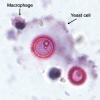Multiple Disguises for the Same Party: The Concepts of Morphogenesis and Phenotypic Variations in Cryptococcus neoformans
- PMID: 21922016
- PMCID: PMC3167222
- DOI: 10.3389/fmicb.2011.00181
Multiple Disguises for the Same Party: The Concepts of Morphogenesis and Phenotypic Variations in Cryptococcus neoformans
Abstract
Although morphological transitions (such as hyphae and pseudohyphae formation) are a common feature among fungi, the encapsulated pathogenic yeast Cryptococcus neoformans is found during infection as blastoconidia. However, this fungus exhibits striking variations in cellular structure and size, which have important consequences during infection. This review will summarize the main aspects related with phenotypic and morphological variations in C. neoformans, which can be divided in three classes. Two of them are related to changes in the capsule, while the third one involves changes in the whole cell. The three morphological and phenotypic variations in C. neoformans can be classified as: (1) changes in capsule structure, (2) changes in capsule size, and (3) changes in the total size of the cell, which can be achieved by the formation of cryptococcal giant/titan cells or microforms. These changes have profound consequences on the interaction with the host, involving survival, phagocytosis escape and immune evasion and dissemination. This article will summarize the main features of these changes, and highlight their importance during the interaction with the host and how they contribute to the development of the disease.
Keywords: Cryptococcus neoformans; antigenic variations; capsule enlargement; giant cells; micro-cells; morphogenesis.
Figures


Similar articles
-
Phenotypic Variability Correlates with Clinical Outcome in Cryptococcus Isolates Obtained from Botswanan HIV/AIDS Patients.mBio. 2018 Oct 23;9(5):e02016-18. doi: 10.1128/mBio.02016-18. mBio. 2018. PMID: 30352938 Free PMC article.
-
Fungal morphogenetic changes inside the mammalian host.Semin Cell Dev Biol. 2016 Sep;57:100-109. doi: 10.1016/j.semcdb.2016.04.008. Epub 2016 Apr 19. Semin Cell Dev Biol. 2016. PMID: 27101887 Review.
-
Cryptococcal Titan Cells: When Yeast Cells Are All Grown up.Curr Top Microbiol Immunol. 2019;422:101-120. doi: 10.1007/82_2018_145. Curr Top Microbiol Immunol. 2019. PMID: 30406867 Review.
-
The Transcription Factor Pdr802 Regulates Titan Cell Formation and Pathogenicity of Cryptococcus neoformans.mBio. 2021 Mar 9;12(2):e03457-20. doi: 10.1128/mBio.03457-20. mBio. 2021. PMID: 33688010 Free PMC article.
-
Titan cells in Cryptococcus neoformans: cells with a giant impact.Curr Opin Microbiol. 2013 Aug;16(4):409-13. doi: 10.1016/j.mib.2013.03.006. Epub 2013 Apr 12. Curr Opin Microbiol. 2013. PMID: 23588027 Free PMC article.
Cited by
-
A dissemination-prone morphotype enhances extrapulmonary organ entry by Cryptococcus neoformans.Cell Host Microbe. 2022 Oct 12;30(10):1382-1400.e8. doi: 10.1016/j.chom.2022.08.017. Epub 2022 Sep 12. Cell Host Microbe. 2022. PMID: 36099922 Free PMC article.
-
Phenotypic Variability Correlates with Clinical Outcome in Cryptococcus Isolates Obtained from Botswanan HIV/AIDS Patients.mBio. 2018 Oct 23;9(5):e02016-18. doi: 10.1128/mBio.02016-18. mBio. 2018. PMID: 30352938 Free PMC article.
-
The Crucial Role of Biofilms in Cryptococcus neoformans Survival within Macrophages and Colonization of the Central Nervous System.J Fungi (Basel). 2017 Feb 24;3(1):10. doi: 10.3390/jof3010010. J Fungi (Basel). 2017. PMID: 29371529 Free PMC article. Review.
-
Lineages Derived from Cryptococcus neoformans Type Strain H99 Support a Link between the Capacity to Be Pleomorphic and Virulence.mBio. 2022 Apr 26;13(2):e0028322. doi: 10.1128/mbio.00283-22. Epub 2022 Mar 8. mBio. 2022. PMID: 35258331 Free PMC article.
-
Capsule-Deficient Cryptococcal Meningitis: A Diagnostic Conundrum.J Glob Infect Dis. 2022 Nov 15;14(4):165-169. doi: 10.4103/jgid.jgid_255_21. eCollection 2022 Oct-Dec. J Glob Infect Dis. 2022. PMID: 36636299 Free PMC article.
References
-
- Aksenov S. I., Babyeva I. P., Golubev V. I. (1973). On the mechanism of adaptation of micro-organisms to conditions of extreme low humidity. Life Sci. Space Res. 11, 55–61 - PubMed
-
- Anna E. J. (1979). Rapid in vitro capsule production by cryptococci. Am. J. Med. Technol. 45, 585–588 - PubMed
-
- Casadevall A., Mukherjee J., Devi S. J., Schneerson R., Robbins J. B., Scharff M. D. (1992). Antibodies elicited by a Cryptococcus neoformans-tetanus toxoid conjugate vaccine have the same specificity as those elicited in infection. J. Infect. Dis. 165, 1086–109310.1093/infdis/165.6.1086 - DOI - PubMed
LinkOut - more resources
Full Text Sources

